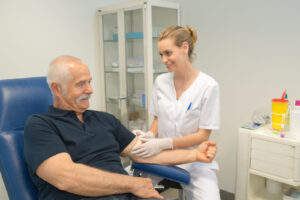Have you ever heard of the term phlebotomy? It is a rather peculiar term that not a lot of people are familiar with. However, a lot of us are already familiar with the process of phlebotomy. But we call it by different names.
Let’s dive in deeper. Phlebotomy is a procedure that uses a needle to take the patient’s blood from their vein. In layman’s terms, it is a blood draw.
Usually, the process of phlebotomy takes blood from the patient’s arm. This procedure is also known by many as a blood extraction or venipuncture. The person who does this is known as a phlebotomist.
How Long Is Phlebotomy Training?
To become a phlebotomist, you will need to undergo education and training programs as well as certification. But just how long is phlebotomy training?
Giving an exact timeframe would be tricky. There are many factors that will affect the length of your training to become a phlebotomist. The timeframes that we will give you in this article are just average estimations based on the factors.
Training to become a phlebotomist may take you from four months to a year and a half. It highly depends on the school and training program you choose.
The place where you will take a certification exam is also a factor. Education and practicum training will take somewhere from 3 months to a year on average. You may spend an additional 20-40 hours of coursework to get the certification.
To make it short, about two-thirds of phlebotomy training will be spent in classrooms while one-third will be spent on internships or externships. But the time you will spend on your certification exams will differ depending on where you will have your exam.
Phlebotomy Exams
Usually, exams last 2 hours or more with at least 80 items but it can be more than that. You can take a certification exam for phlebotomy through any of these six programs:
- American Society for Clinical Pathology
- Association of Phlebotomy Technicians
- American Medical Technologists
- National Center for Competency Testing
- National Healthcareer Association
- American Medical Certification Association
However, you cannot just choose between exams based on which one of them you prefer. Rather, it is more of a function of what your state requires. And each exam has its own requirements. In some states, you may need licensure to become a phlebotomist.
As you can see, becoming a phlebotomist is not as easy as one may think. It requires focus and expertise that can be gathered through education and training. But it can be a highly rewarding career and one that is worth the effort to pursue.
Therapeutic Phlebotomy
Therapeutic phlebotomy is a procedure that can be used for diagnosing different kinds of medical conditions. But aside from diagnosis purposes, therapeutic phlebotomy can also be used as a treatment for certain medical conditions.
Some of the medical conditions that therapeutic phlebotomy can treat include the following:
- Hemochromatosis
- Sickle cell disease
- Nonalcoholic fatty liver disease
- Polycythemia vera
Therapeutic phlebotomy is not a duty of doctors and nurses, but rather, it is performed by medical professionals known as phlebotomists. Many phlebotomists work in pathology labs of hospitals and clinics.








